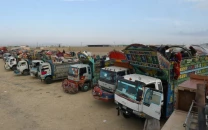The obverse side of the coin
In most cases, it is the seth, having no entrepreneurial skills, who runs these units guided by personal whims

The writer served as Executive Editor of The Express Tribune from 2009 to 2014
It has further claimed that 25 per cent of working capital has been stuck in a refund regime, creating a severe cash flow crunch, while the industry has been over-burdened with taxes and levies at a time when the costs of inputs have soared through the ceiling, pricing our textile exports out of the international markets. The electricity rate for the industry is said to have been fixed at 15 cents per unit while the average rate in the region is eight cents per unit. Through the same ad, the PTEA has demanded the release of exporters’ refunds, easing of other financial stresses and reduction in crippling tax burdens. The demands also include grants of subsidies and other incentives, especially the release of those that had already been announced earlier. While one would like the government to treat the matter with utmost urgency and due empathy in view of the fact that the textile industry is not only our largest employment generating sector, but also makes up almost two-third of our economy, it would not be out of place here to take a look at the obverse side of the coin as well.
Over the years, this sector, with the exception of a handful, has wallowed in windfall gains without making any effort at value-addition or marketing. It has also failed to adopt the modern technological and managerial techniques needed to enhance its productivity and the quality of its produce. For ages, the sector has kept its processing activities confined to spinning and making yarn, first for the Japanese and lately for the Chinese value-addition industries, both captive and hungry markets. These economies, especially the Chinese, went into top gear over the last 20 years. More than anything else, it is because of the sudden decline in the demand for our low-end textile products in the Chinese market, following the slowing down of its overall economy, that our textile exports have started crashing. And it was around this time that electricity rates in our country began going up, rendering our export goods uncompetitive in the world market. The situation got compounded when we failed to keep to our importers’ supply schedule because of extended load-shedding which, at times, followed no schedule at all.
When the UK’s Northern Rock was rocked by a subprime mortgage crisis in early 2008 in the face of the global financial crisis, the UK government, this great advocate of the market economy, did not think twice before nationalising the bank to save its economic backbone — the financial sector — from keeling over. This event has not been recalled here to make a case for nationalising the troubled textile sector in case the government is convinced that most of its demands are unreasonable, but to warn the sector to find a way out at the earliest so as to save the national economy from crashing along with the sector itself.
The main reason why a large section of the textile sector is in such a bad shape and is not in a position to meet the challenges of the fluctuations in the domestic and world markets with any degree of level-headedness on its own, is because most of the units are run by boards of directors packed with family members and flunkies. Such boards hardly help manage the units professionally. In most cases, it is the seth, having no entrepreneurial skills, who runs these units guided by personal whims. The Securities and Exchange Commission of Pakistan should take a close look at these boards and try to get them to strengthen themselves with professionals. If changes in laws are needed in order to introduce reforms, then so be it.
Published in The Express Tribune, August 19th, 2015.
Like Opinion & Editorial on Facebook, follow @ETOpEd on Twitter to receive all updates on all our daily pieces.



















COMMENTS
Comments are moderated and generally will be posted if they are on-topic and not abusive.
For more information, please see our Comments FAQ